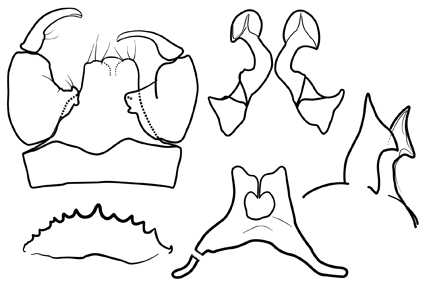Abstract
Five species of the Holarctic genus Schizohelea occurring in Europe and North Africa are reviewed, diagnosed and illustrated. These are S. leucopeza (Meigen, 1804), S. incerta (Clastrier, 1963), S. algeriana Szadziewski, Dominiak, Rumišek et Rupp, sp. nov., S. clastrieri Szadziewski, Dominiak, Rumišek et Rupp, sp. nov. and S. withersi Szadziewski, Dominiak, Rumišek et Rupp, sp. nov. The male of North African S. incerta is described for the first time. Schizohelea algeriana and S. clastrieri are described from northern Algeria, and S. withersi from southern France. An identification key to all species of the genus is provided.
References
- Borkent, A. & Dominiak, P. (2020) Catalog of the biting midges of the world (Diptera: Ceratopogonidae). Zootaxa, 4787 (1), 1–377. https://doi.org/10.11646/zootaxa.4787.1.1
- Borkent, A., Dominiak, P. & Díaz, F. (2022) An update and errata for the catalog of the biting midges of the world (Diptera: Ceratopogonidae). Zootaxa, 5120 (1), 53–64. https://doi.org/10.11646/zootaxa.5120.1.3
- Borkent, A., Dominiak, P. & Szadziewski, R. (2013) Fauna Europaea: Ceratopogonidae. In: Beuk, P. & Pape, T. (eds), Fauna Europaea: Diptera, Nematocera. Fauna Europaea.
- Clastrier, J. (1963) Notes sur les Cératopogonidés. XVIII.—Espèces du genre Stilobezzia Kieffer ou Apparentées de la Région Paléarctique. Archives de l’Institut Pasteur d’Algérie, 41, 41–68.
- Coquillett, D.W. (1901) New Diptera in the U.S. National Museum. Proceedings of the United States National Museum, 23, 593–618. https://doi.org/10.5479/si.00963801.23-1225.593
- Downes, J.A. (1978) Feeding and mating in the insectivorous Ceratopogoninae (Diptera). Memoirs of the Entomological Society of Canada, 104, 1–62. https://doi.org/10.4039/entm110104fv
- Downes, J.A. & Wirth, W.W. (1981) Ceratopogonidae. In: McAlpine, J.F., Peterson, B.V., Shewell, G.E., Teskey, H.J., Vockeroth, J.R. & Wood, D.M. (Coords.), Manual of Nearctic Diptera. Vol. 1. Agriculture Canada Monographs 27. Canadian Government Publishing Centre, Ottawa, pp. 393–421.
- Kieffer, J.J. (1915) Neue Chironomiden aus Mitteleuropa. Brotéria, Serie Zoologica, 13, 65–87.
- Kieffer, J.J. (1917) Chironomides d’Amerique conservés au Musée National Hongrois de Budapest. Annales Historico-Naturales Musei Nationalis Hungarici, 15, 292–364.
- Mayer, K. (1937) Beitrag zur Kenntnis der deutschen Ceratopogoniden. (Dipt.) IX. Stettiner Entomologische Zeitung, 98, 301–304.
- Meigen, J.W. (1804) n.k. In: Klassifikazion und Beschreibung der europäischen zweiflügeligen Insekten (Diptera Linn.). Erster Band. Abtheilung I & Abtheilung II. Reichard, B Braunschweig, pp. i–xxviii + 1–152, pls. 1–8 & pp. i–vi + 153–314, pls. 9–15.
- Mullen, G.R. & Hribar, L.J. (1988) Biology and feeding behavior of ceratopogonid larvae (Diptera: Ceratopogonidae) in North America. Bulletin of the Society for Vector Ecology, 13, 60–81.
- Remm, H. (1967) On the fauna of Ceratopogonidae (Diptera) in the Caucasus [in Russian]. Tartu Riikliku Ulikooli Toimetised, 194, 3–37.
- Remm, H. (1980) New species of the family Ceratopogonidae (Diptera) from the Middle Asia [in Russian, English summary]. Tartu Riikliku Ulikooli Toimetised, 516, 85–128.
- Remm, H. (1993) New species of Ceratopogonidae (Diptera) from the CIS [in Russian, Estonian and English summaries]. Eesti Teaduste Akadeemia Toimetised, Bioloogia, 42, 180–200.
- Szadziewski, R. (1988) Biting midges (Diptera, Ceratopogonidae) from Baltic amber. Polskie Pismo Entomologiczne, 58, 3–283.
- Szadziewski, R., Grogan, W.L., Sontag, E. & Bojarski, B. (2022) A new genus of predatory midge in the Monohelea complex from Eocene Baltic amber (Diptera: Ceratopogonidae). Insecta Mundi, 0919, 1–9.
- Wiedemann, C.R.W. (1817) Neue Zweiflügler (Diptera Linn.) aus der Gegend um Kiel. Zoologisches Magazin, 1, 61–86.
- Winnertz, J. (1852) Beitrag zur Kenntniss der Gattung Ceratopogon Meigen. Linnaea Entomologica, 6, 1–80. https://doi.org/10.5962/bhl.title.14229
- Wirth, W.W. (1953) American biting midges of the heleid genus Monohelea. Proceedings of the United States National Museum, 103, 135–154. https://doi.org/10.5479/si.00963801.103-3320.135
- Wirth, W.W. & Grogan, W.L. Jr. (1988) The predaceous midges of the world (Diptera: Ceratopogonidae; Tribe Ceratopogonini). Flora and Fauna Handbook 4. E.J. Brill, Leiden, New York, Københaven and Köln, xv + 160 pp. https://doi.org/10.1163/9789004630208


